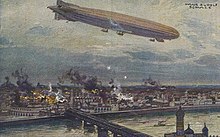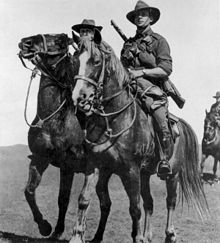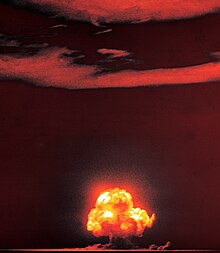Wikipedia:WikiProject Military history/News/June 2015/Op-ed
|
War Horse / Iron Horse |
By June 1915, the Central and Allied Powers engaged in the First World War had been forced to adopt and improvise tactics in response to new technology barely dreamed of by nations or armies twelve months prior. This month a century ago saw the first anniversary of the assassination of the Archduke Francis Ferdinand and his fiancée in Sarajevo, so it seems appropriate to reflect on the rising military–industrial complex, which had by this time begun to exert its pull on the course of the war.

It was at this point no secret that
The Allied and Central Powers had also begun to flesh out early plans for

The naval forces of the Allied and Central powers began fighting each other with surface engagements intended to support invasion forces. In 1915, the Imperial German Navy began a campaign of unrestricted
Historically, war has always breed innovation; in periods of conflict the human race tends to rapidly advance its technological and scientific boundaries to meet the demands placed upon the nations in question to defeat their enemies. By June 1915, both the Allies and Central Powers were beginning to see the full impact of this effect not only in the technology and strategies being introduced, but in the rapid obsolescence of some long standing military doctrines, strategies, and equipment. Most noticeably for nearly all sides at this point in the war was the apparent obsolescence of the
On the Western Front of World War I alone, the horse was rather abruptly displaced from its position of honor as a result of
While the impact of the changes being brought about by the military–industrial complex was not lost on the participating nations, some of the greatest and most memorable weaponry had yet to make its debut, and some of the bloodiest battles of the war had yet to be fought. Undoubtedly though, one year into the war, many military commanders and heads of state must have wondered exactly how deep the Pandora's box they had opened in July of 1914 went, and how high the price in men, machines, and money would be for their hubris in thinking that such a massive conflict could be won so easily in the first major conflict of the industrialized age. Although not approaching the size or scope of the war then being fought in Europe, the United States had experienced the bitter taste of an industrialized conflict during its Civil War, and had come to understand what machines like the railroad locomotive and the armored steamboat could do in battle. Perhaps it was these still-recent memories that had compelled the US administration to cling so steadfastly to the declaration of neutrality issued at the start of World War I, for fear of what the next major industrialized war would look like, and the fear of the cost to paid by volunteering to fight on increasingly industrialized and mechanized battlefields.
|




